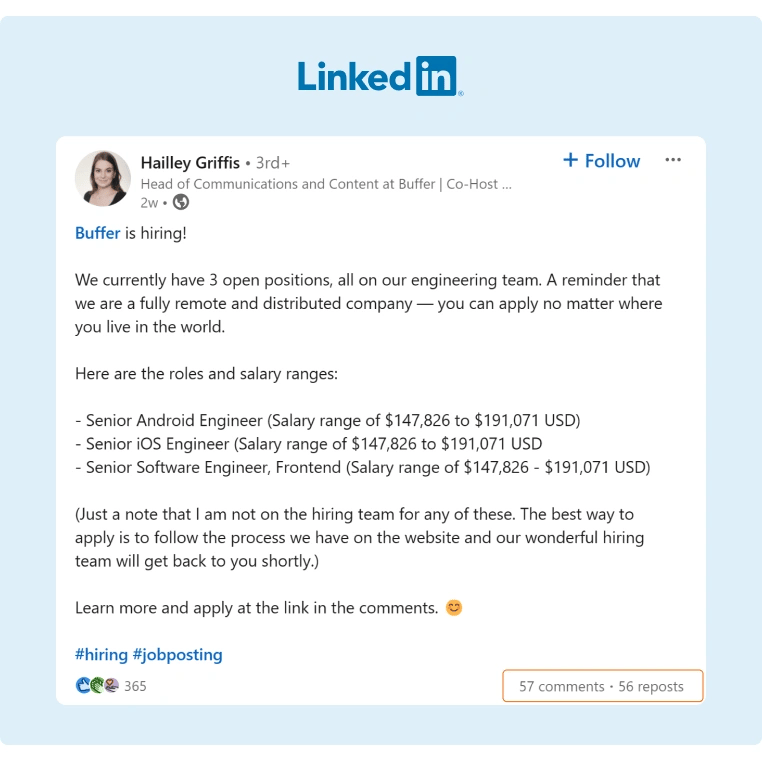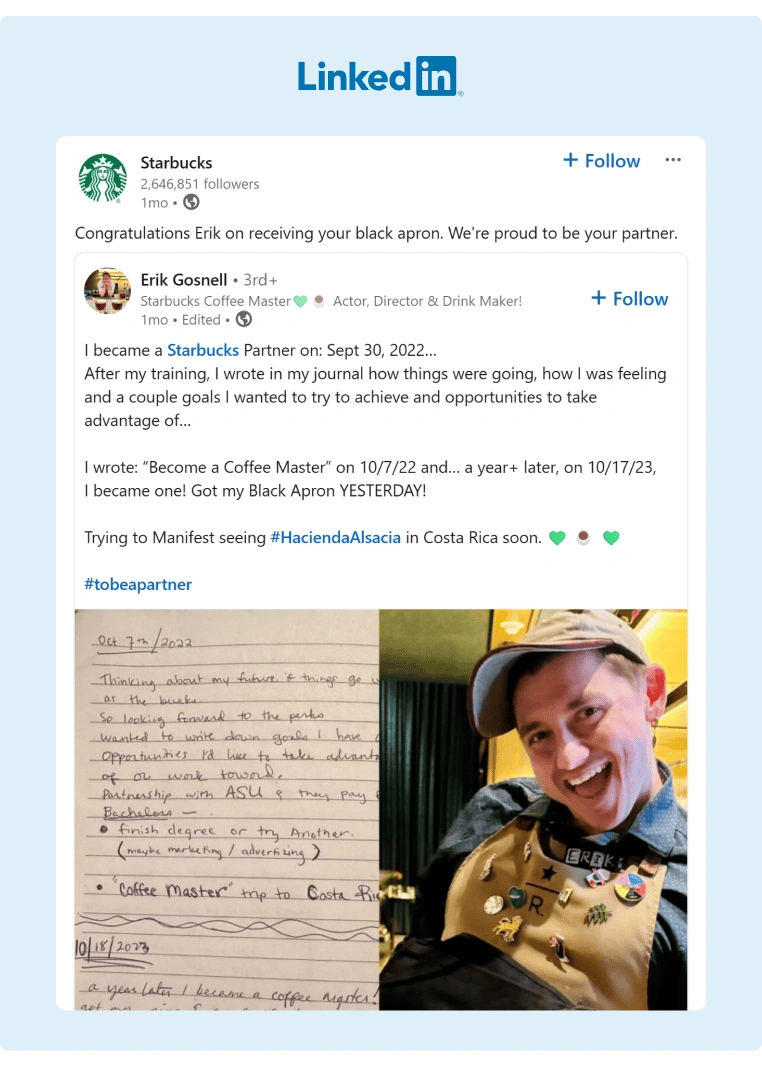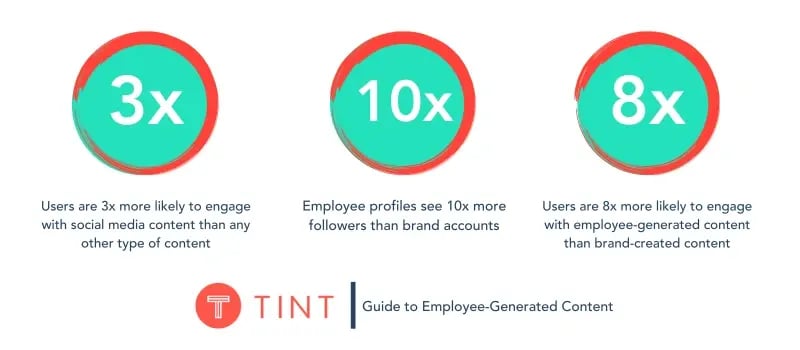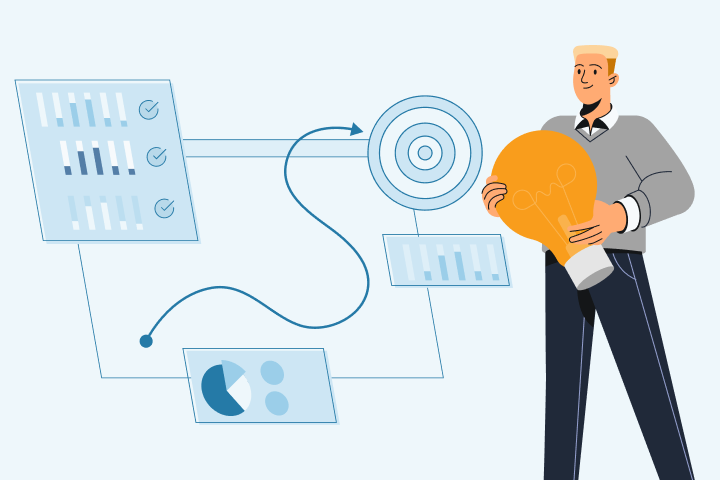Building a Talent Pipeline With Employee-Generated Content
Attracting top talent in today’s B2B tech job market is no easy feat. While a potential candidate might look great on paper, too often a company later discovers the individual is a mismatch when it comes to the brand’s culture, mission, and/or ethics. Unfortunately, this discovery typically occurs after the onboarding process has been completed, which impacts employee productivity, morale, and ultimately, turnover.
So, how do you attract the right candidates for your brand? The answer: incorporate employee-generated content (EGC) into your marketing strategy.
Effective employee-generated content — amplified by employee advocacy —- builds trust and authenticity through employee influencer-style shared content. It attracts and engages potential candidates who align with your brand’s ethos.
In this article, we’ll explain how to use employee-generated content to build a strong talent pipeline plus share examples of content types you can use in your strategy.
Let’s get started.
What Is Employee-Generated Content?
Employee-generated content is a type of user-generated content (UGC) that helps boost brand awareness and engagement while building brand trust and credibility with targeted audiences. Content is created and shared by your own team members, giving potential candidates an authentic peek into what it is like to work for your company.
 Source: Krist F.
Source: Krist F.
When employees share their own thoughts on social platforms (e.g., LinkedIn, Facebook, etc.) your brand messaging is viewed as more trustworthy and personable. It’s no secret that people trust other people more than they trust brands or ads. Social media posts from employee influencers reach 5x further than posts from brands, get reshared 24x more frequently, and achieve a 200% higher click-through rate.
Now imagine leveraging your staff as workplace influencers to recruit top talent. And when paired with recruitment software like Oleeo, employee-generated content is a cost-effective marketing strategy that can enhance the talent acquisition process.
How EGC Enhances the Talent Acquisition Process
Now let’s take a look at how employee-generated content can enhance your brand’s talent acquisition process.
Attracts Passive Job Seekers Through Engaging Employee Content
Passive candidates are top talent who are currently content in their positions and are not looking for a new job opportunity. But, don’t let that stop you from adding them to your talent pipeline. By engaging passive candidates with your employee-generated content, you’ll be grabbing their attention and cultivating a connection, which takes time.
 Source: Hailley Griffis
Source: Hailley Griffis
Remember employee-generated content is a long-game strategy, and understanding the difference between talent acquisition and recruitment is important here. While recruitment often focuses on filling vacancies quickly, talent acquisition is about strategically building relationships and a workforce for the long-term needs of the company.
To optimize your recruitment strategy, consider integrating talent acquisition software including a feedback tool like SurveySensum’s NPS software, which can provide insights into how both external audiences and employees perceive your brand. Another helpful tool is CRM recruitment software to compile passive candidates for future reference. And of course, an employee advocacy platform like GaggleAMP to give your employees a platform for creating, sharing, and engaging with content.

Enhances Employer Brand by Showcasing Real Employee Experiences
Employer branding is how you market your company to job seekers. An effective employer branding strategy helps promote a company’s culture, values, and employee value proposition (EVP). This strategy helps the brand stand out from its competitors and generate a positive reputation in the job market, which, in turn, attracts the right talent.
 Source: Starbucks
Source: Starbucks
Employee branding through employee advocacy enables your employees to be your biggest supporters. Through their employee-generated content, they can showcase real employee experiences along with why they love working at your company to potential candidates.
Aligns Prospective Candidates With Company Culture and Expectations
The hiring process can be time-consuming and expensive. Imagine interviewing a candidate who looks great on paper but the interview ends up being a disaster. Now imagine using employee advocacy to share employee-generated content to get the word out about your company’s culture and expectations.
 Source: Cisco
Source: Cisco
Let’s say you’re a brand who’s seeking a new Director of Sales. A potential candidate sees your job posting, checks out your website, and finds an employee’s blog post about digital innovation strategies. Impressed with your company's forward thinking attitude the candidate immediately applies.
Here, employee-generated content has provided the proof that was needed to demonstrate why your position is worth applying for. It’s a great way to show that you’re dedicated to investment and an exciting organization to be a part of, whilst also demonstrating what you’re expecting of a new employee, namely, innovation and being at the forefront.
For most positions, skills can be taught and refined. However, it isn’t easy to change someone’s values, morals, and ethics. The right employee content helps you to emphasize your brand’s values and morals, so you can avoid problems further down the line.
Improves Candidate Experience With Authentic Company Insights
Employer branding improves your recruitment process by empowering current employees who have been through the interview (and later onboarding) process to share what to expect and how to prepare.
Through employee testimonials, candidates can imagine themselves in the role and what it is like working for your company. Candidates are also more likely to recognize familiar faces from your employee-generated content, making them feel connected to your staff.

Source: Amy Varcoe
Now let’s take a look at how to seamlessly integrate employee-generated content into your recruitment strategy.
Integrating Employee-Generated Content Into Your Recruitment Strategy
Before your employees can start creating and sharing their own content, your brand needs an employee-generated content strategy. Once that’s developed, then you can implement it into your recruitment strategy.
Here are six steps to create an effective employee-generated content strategy:
-
Determine Company Goals. Narrow down your recruitment goals. Are you looking to generate more likes, shares, traffic, and engagement, or perhaps, you want to hire x number of individuals per quarter? Just as you would set RPO metrics to track the performance of an external recruitment agency, you equally need to make sure that your own strategy has some accountability.
-
Select Target Platforms. Determine which social media platforms (e.g., LinkedIn, X, Facebook, Instagram, Tiktok) your employees will be posting (and engaging with) content on.
-
Assign Employees To Create Content. Pick which employees will be responsible for creating social media content. Provide them with training, brand guidelines, and other relevant information so they have the tools and information needed to produce high-quality content.
-
Create Engaging Social Content. Popular types of content include employee spotlights, company news, thought leadership, etc. Tailor your content to your target audience segment and social platform.
-
Implement an Employee Advocacy Tool. Getting employees to create, distribute, and engage with content is no easy task. This is where an employee advocacy tool like GaggleAMP can help. It streamlines the process for managers and employees plus provides analytics to track their employee advocacy efforts.
-
Track and Measure Results. If you’re using an employee advocacy platform like GaggleAMP, you’ll be able to track key metrics like clicks, reach, employee earned media value (EEMV), and shares. This will help you see which employee-generated content posts performed best and which posts need to be modified.

Now let’s take a look at some specific types of content that can help build a strong talent pipeline.
Examples of Employee-Generated Content
According to TINT’s Guide to Employee-Generated Content, users are 3x more likely to engage with social media posts and 8x more likely to engage with employee-generated content than brand-created content.

Source: TINT
To reap these benefits and attract top talent for your pipeline, here are six examples of employee-generated content that will engage and delight potential candidates:
1. Social Media Posts
Sharing content on social media platforms (e.g., LinkedIn, Facebook, TikTok) can help extend your brand’s reach, capturing the attention of top talent. Your target audience (e.g., Boomers, Millennials, Gen Z) will influence which platforms you post on. However, LinkedIn is the top platform for recruiting all age groups and demographics.
Moz is a great example of a B2B brand with a robust LinkedIn presence. Here, Moz reposts its employees’ generated content to further brand reach and engagement.

Source: Meghan Pahinui
2. Blog Posts
Company blogs are a great platform for showcasing your employees’ thought leadership content and case studies, which can also be shared to your company and employees’ social platforms. HubSpot’s blog is a go-to resource for employees, potential candidates, and customers.

Source: HubSpot
3. Thought Leadership
Tap the thought leaders from your team to share expert knowledge, industry insights, and thoughts on trends. This can be in the form of webinars, live-streams (recorded to reshare), and guest blogs with relevant brands.

Source: Chad Rosh
4. Multimedia Content
Photo, video, and carousel posts are perfect for elevating employee-generated content beyond a generic social media post. They can bring to life behind-the-scenes, company events, and employee spotlight content.
Semrush’s LinkedIn company page has an entire section dedicated to Life at Semrush, including a section “Trending employee content” featuring a carousel of posts from its employees.

Source: Semrush
5. Employee Testimonials
Employee testimonials are another great tool for building trust with potential candidates. When an employee explains why they love to work for your company, or shares the professional growth opportunities that they’ve experienced during their tenure, it’s viewed as more genuine versus a company who says its employees love working for them.
Carving out a space on your website and LinkedIn company page’s profile to feature testimonials will further humanize your brand. You can also repurpose these testimonials, turning them into social media posts to share.
 Source: Zhongqi Li
Source: Zhongqi Li
6. Interactive Content
Interactive content is a great way of building a connection between prospective employees and your brand. Thought-provoking questions, quizzes, polls will encourage potential candidates to engage with your brand and employees. It’s also a great way to collect data and get a feel for industry recruitment trends.

Source: Dean Lee
These are just a few of the many types of content you can use to build a strong talent pipeline. Feel free to use a few or all of these examples of employee-generated content.
Final Thoughts
Effective employee-generated content can enhance your employer branding which boosts your ability to attract top talent. To optimize your content strategy and build a robust talent pipeline, an employee advocacy tool like GaggleAMP can support employee buy-in and streamline your advocacy efforts.
Ready to take your recruitment to the next level? Start your GaggleAMP trial today











